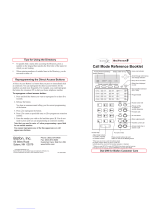Off-Hook Voice Announce ..................................................................................39–40
OHVA Block ......................................................................................................................40
OHVA Reject ....................................................................................................................40
In Group/Out of Group ................................................................................................40
CUSTOMIZING YOUR KEYSET
AME Password ................................................................................................................41
Auto Camp-On ................................................................................................................41
Select Ring Tone ............................................................................................................41
Change Your Passcode ................................................................................................41
Set Answer Mode (Intercom) ....................................................................................42
Set Answer Mode (CO) ................................................................................................42
Automatic Hold ..............................................................................................................42
Headset Operation ........................................................................................................42
Hot Keypad ......................................................................................................................43
Key Confirmation Tone ................................................................................................43
Rejoining a Page ............................................................................................................43
Ring Preference ..............................................................................................................43
Auto Answer CO Calls ..................................................................................................44
Display Speed Dial Name............................................................................................44
Caller ID Review All........................................................................................................44
Secure OHVA....................................................................................................................44
DISPLAY FEATURES
Interactive Display Keys ..............................................................................................45
Directory Information ................................................................................................ 45
Call Log ..............................................................................................................................46
Dial by Name....................................................................................................................46
Call Progress Displays ..................................................................................................46
Display Number Dialed................................................................................................47
Call Duration Timer........................................................................................................47
Auto Timer ........................................................................................................................47
Timer Function ................................................................................................................47
Viewing Message Indications ....................................................................................48
Alarm Reminder Messages..................................................................................48–49
Personal Speed Dial Names........................................................................................49
Station Names ................................................................................................................49
Managing Key Assignments ......................................................................................50
LCR with Clear .................................................................................................................50
Backspace with LCR ......................................................................................................50
idcs_keyset.qxp 9/23/2005 11:31 AM Page 5
Text Messaging ......................................................................................................51–52
Caller ID .....................................................................................................................53–57
ANI .............................................................................................................................54–57
CLI ..............................................................................................................................54–57
iDCS 64B MODULE WITH KEYSET ........................................58
SVMi E-Series ..................................................................................................59
SVMi E-Series Subscriber Services Menu Diagram ....................................60–61
Accessing your Mailbox ............................................................................................62
Getting Started ...............................................................................................................63
Listen to your Messages .............................................................................................63
Subscriber Services Menu .........................................................................................63
Listening to Old or New Messages .........................................................................64
Group New or Old Messages ....................................................................................65
Record and Send a Message......................................................................................65
Access Manager ............................................................................................................66
Personal Greetings ........................................................................................................68
Mailbox Administration ..............................................................................................70
Message Broadcast ......................................................................................................72
Personal Services ...........................................................................................................73
Personal Administration Settings ............................................................................74
Keyset User Features ...................................................................................................75
Shortcuts .........................................................................................................................77
Interactive Displays .......................................................................................................77
PERSONAL SPEED DIAL NUMBERS ............................78–79
idcs_keyset.qxp 9/23/2005 11:31 AM Page 6




















